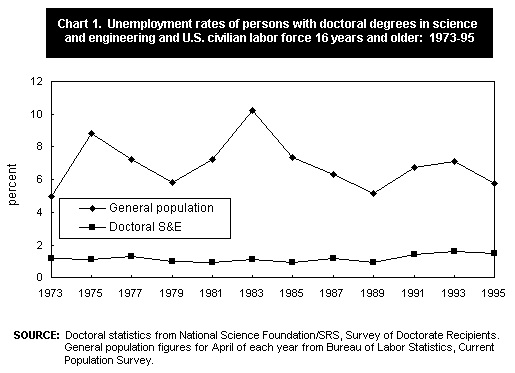
Directorate for Social, Behavioral
and Economic Sciences
NSF 97-318 August 14, 1997
 |
NATIONAL SCIENCE FOUNDATION Directorate for Social, Behavioral and Economic Sciences
NSF 97-318 August 14, 1997 |
| by Carolyn F. Shettle |
 |
Cause for Alarm? |
| How
high is the unemployment rate for people with doctoral degrees in science and engineering (S&E)? Is it unusually high? Will current and future graduate school students have trouble finding jobs? These questions are among those being discussed by
science and graduate education policy makers, as well as by individuals in—or planning to enter—the doctoral science and engineering job market and those responsible for programs serving them.
Statistical information about unemployment among persons with U.S. S&E doctorates under age 76 is presented here. Additional information on such related topics as involuntary-part-time-employment, involuntary-out-of-field employment, unemployment within population subgroups, and information on those with degrees from foreign institutions is needed for a comprehensive understanding of the doctoral S&E labor market.[1]
How high are unemployment rates for doctoral scientists and engineers in the 1990s?

Despite the relatively low rate of unemployment in the doctoral population compared to the total population, the 1993 unemployment rate (1.6 percent) was the highest ever observed in the biennial Survey of Doctorate Recipients (SDR), beginning in 1973. This is consistent with the observations of many others that unemployment in the doctoral science and engineering population was unusually high in the early 1990s.
Do trends in unemployment rates among those with S&E doctorates mirror those in the general population?
What is the relationship between educational level and unemployment?
The relatively low rate of unemployment in the doctoral S&E population is consistent with the fact that unemployment rates decrease as educational level rises in the general population (Chart 2). Between 1973 and 1995, there was a strong negative correlation between educational level and unemployment.

Not only did fluctuations in unemployment rates decrease with increasing education, but there was also less fluctuation in unemployment rates for the doctoral population than for other educational groups between 1973 and 1995. The ratio of maximum to minimum unemployment rates during this period was 1.8 for the doctoral population, 2.1 for the college-educated population, and approximately 3.0 for those with no more than a high school education.
Will future graduate students have trouble finding jobs? Even those specialized models are not yet thought to be adequate for projecting long term unemployment. According to the Report of the Ad Hoc Working Group on the Supply of Science, Engineering and Mathematics (SEM) Professionals (1993), "It is not currently possible and will probably never be possible to predict with a high degree of accuracy shortages or surpluses of scientists and engineers several years into the future." A similar sentiment was echoed in a more recent publication by Tobias et. al. (1995), "Given the time lag in producing scientists,...it is particularly hard to predict, no less adjust, supply and demand." (p. 16).
References and Related Publications: Bureau of Labor Statistics, data from the Current Population Survey, (downloaded data, special tabulations, and information in U.S. Department of Labor, Report on the American Workforce, 1994.) National Science Foundation, Characteristics of Doctoral Scientists and Engineers in the United States: 1987, 1989, 1991, 1993, and 1995 (NSF 88-331, 91-317, 94-307, 96-302 and forthcoming) plus data from 1993 SESTAT data base (http://www.nsf.gov/statistics/). Tobias, Sheila, Daryl E. Chubin, and Kevin Aylesworth, Rethinking Science as a Career. Perceptions and Realities in the Physical Sciences, Research Corporation, Tucson, Arizona, copyright, 1995. For more information on doctoral unemployment, see NSF's forthcoming publication, Who is Unemployed? Factors Affecting Unemployment Among Individuals with Doctoral Degrees in Science and Engineering to be released in hard copy and on the Web (http://www.nsf.gov/statistics/) or contact:
Dr. Carolyn F. Shettle For free copies of SRS Issue Briefs, write to the above address, call 703-306-1130, or send e-mail to pubs@nsf.gov.
|
[1] Information on many of these topics is available from current SRS publications. This Issue Brief presents information on all Ph.D.s under age 76, in contrast to "Labor market Conditions for Recent Ph.D. Recipients: 1993 to 1995 Changes Vary Greatly by Field," which focuses on recent degree recipients.